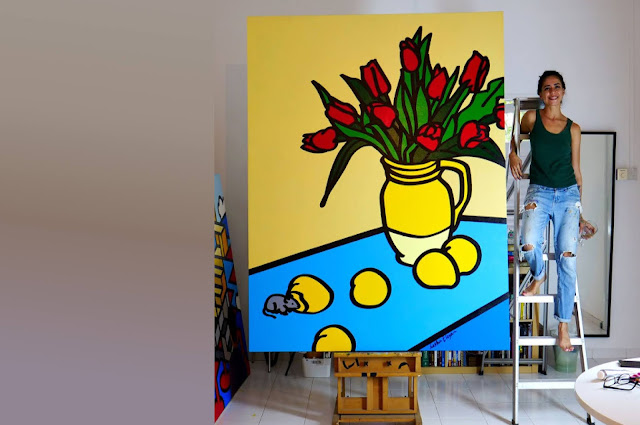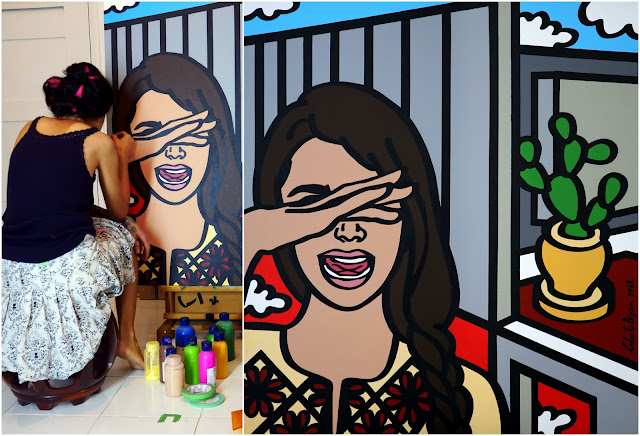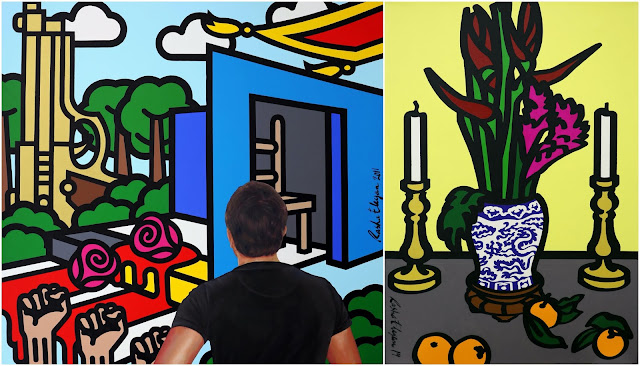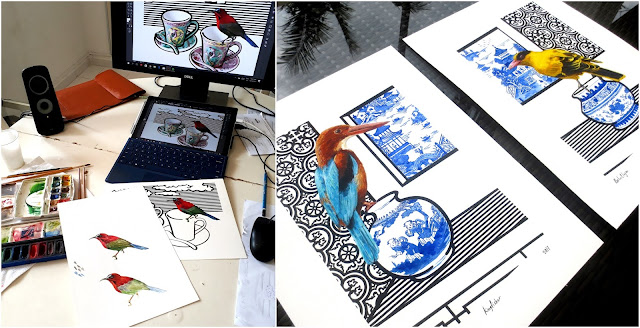Interview with artist Rasha Eleyan
Rasha Eleyan was born in Dubai to Palestinian parents.
From an early childhood, she was mentored by her father, the great Palestinian artist Nasr Abdelaziz Eleyan, in the art of drawing and oil painting.
Rasha went on to graduate with a BA in Fine Arts from the Yarmouk University in Jordan, and advanced painting and nude drawing from the Libera Accademia Di Belle Arti of Rome.
Rasha’s artistic career began as an illustrator for children’s story books at just 18 years of age. She later became an associate producer at Walt Disney.
After having a very successful career as an illustrator and television producer, Rasha is now solely focussed on her art and combines her classical style with her love of cartoons to create a truly unique style.
Read on to learn more about the very talented Rasha Eleyan…
Artist: Rasha Eleyan
How does Singapore as an 'environment' serve as an inspiration for you in your art on voices of fragile women?
I have to say that for me, the word "fragile" is not at all synonymous with women.
All women inspire me. Having lived in Singapore for the past 20 years, the international nature of the country has allowed me to meet a variety of women from different ethnic backgrounds. It has shown me how culture and upbringing can affect personality and how women express themselves - whether in total openness or with a quiet and dignified strength.
At the moment I'm occupied with commissions and a series inspired by Palestine. Still, I do keep regular notes of things women in Singapore (my friends or ladies I have observed) have said or done that I find extremely interesting and inspiring. The Palestinian woman is a central figure in my artwork. Still, for now, as I live in Singapore, my girlfriends from Korea, Indonesia, UK etc. all serve as a constant inspiration for future artworks.
“195th Member (Zaghrouta)”, acrylic on canvas, 2012
"His paintings captured beautiful women with long, dark hair, wearing Palestinian Thobe (traditional dress) carrying out tasks from daily rural life, with a pensive, distant look on their face – as if suspended in time in quiet mourning." ~ Rasha Eleyan
Do you consider Palestinian culture to be vastly different than those in South-East Asia? How do you reflect that in your art?
I admit it took me a while to answer this question because I think Arabic and Southeast Asian cultures are both extremely different and remarkably similar to each other. We both have more in common than we do with Western cultures.
I have to say that this “difference or similarity” does not factor in my work. When I paint about Palestine, I create with resistance and rebellion directing my brush strokes. In comparison, my Southeast Asian inspiration is almost exclusively reliant on visual beauty, whether from my primary influence of Peranakan culture, or from the breathtaking nature that surrounds me here in Singapore.
Left: “The Gardens of Death”, acrylic and oil on canvas, 2011
Right: “My Lucky Dragon”, acrylic on canvas, 2014
What has your past working experience at Disney influenced on your art, towards the line of pop art and photo realistic genre?
Since I was little, I have been a big fan of Disney movies, and as a kid, my favourites were the ones that combined animation with live-action. I was almost obsessed. No, I was entirely obsessed with the idea of a wonderfully colourful world where I can interact with amazing, non-sensical over the top characters, with whom I would argue their twisted logic in long-winded conversations. A world that did not abide by the rules of physics or anything that constitutes as "the social norm". I wanted so badly to walk into that world.
The Disney obsession stayed with me for several years and lasted into my late teens. And I believe that it shaped my style as an artist today as it now has a significant influence on what visually excites me when I allow my realistic figures to occupy that fantasy setting.
Disney has had a life-changing impact on my life. The first time was when I was a child and saw Tinkerbell on television. She was flying and touched the top of the Disney castle with her wand. I was mesmerised by the fairy dust, and I believed in the magic of the wonderful world of Disney.
My father studied animation and had many Disney books in his library, so I copied all the cartoons in them and was good at it. After that, I declared that one day I would work for the Disney company. Luckily I got my wish in 2001 when I worked for Disney Television in Singapore. It was here where I learned firsthand the importance of the efforts and dedication Disney demands to stay true to its brand.
If you want something to be exceptional, you have to have the passion to push yourself and put in the hours to achieve it.
Which example would you give as your favourite art piece using watercolour?
I feel most at home in nature. I chose a very green neighbourhood to live in Singapore. I keep the windows open and admire the greenery and feel privileged every single time I spot birds outside. I have a professional set of binoculars and a little birds of Singapore glossary book. If I spot a bird, I run to the balcony with my binoculars and book in hand, and I mark the bird in my book. It makes me happy.
I think I paint the birds I see outside my window because it's my balance. I'm often consumed and frustrated by issues that I can't and don't want to let go of; the birds bring my attention and awareness back to help me fight my anxieties. Based on this, I have to say that my bird watercolour works are my favourite.
What is the most important step in the planning that goes into your art work? Why is it important in your personal opinion?
For me, visualizing and sketching the artwork is the most critical part. When I can see it is when I truly start to get excited. And then it becomes much easier to invest the hours a sketch requires because I become eager to see the final result in front of me. What you see in the sketch will be what you see on the canvas. I dread making changes on canvas because my technique requires dizzying amounts of layers.
Rasha is currently gathering elements and ideas for her latest series, to protect and explore the identity of a culture that is overshadowed by border trouble reduced to media sound bites. To quote Daniel Quinn, “Every time the Takers stamp out a Leaver culture, a wisdom ultimately tested since the birth of mankind disappears from the world beyond recall.”
Watch this space!







